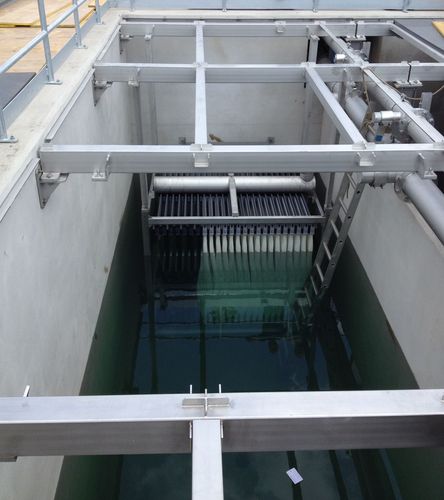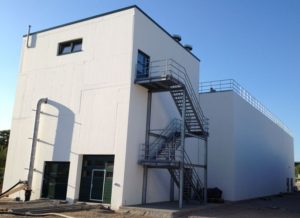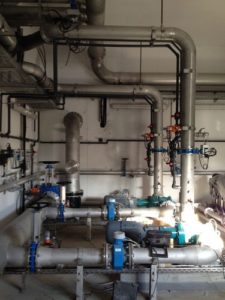Hocheffektives Verfahren der Membranfiltration als Alternative zum konventionellen Belebungsverfahren
Einsatzgebiete | Anwendung
- Kommunale und industrielle Abwasserbehandlung als platzsparendes Konzept mit hoher Reinigungsleistung
- Phasentrennung durch Membrane anstelle des Absetzvorganges – dadurch hohe TS-Gehalte in Belebung, kompakte Bauweise und Verzicht auf Nachklärbecken möglich
Produktbeschreibung
Beim MBR-Verfahren ersetzt das Membranmodul die Nachklärung. Durch einen erhöhten TS-Gehalt im Belebungsbecken kann Bauvolumen eingespart werden.
Das Belebungsbecken wird mit einer Membranfiltration zur Trennung von Wasser und belebtem Schlamm kombiniert. Das biologisch gereinigte Abwasser wird durch die Membran gesaugt. Die Biomasse verbleibt im Belebungsbecken oder in der Filterkammer und muss separat entnommen werden.
Die verfahrenstechnische Auslegung der MBR-Anlage erfolgt als Optimierung zwischen Auslegung des Belebungsbeckens (wie Beckenvolumen, TS-Gehalt, Schlammalter, Luftbedarf) und Auslegung der Membranfiltration (wie Membranfläche, Anzahl der Filtrationseinheiten, Filtrationsvolumen, Permeatflux).
Zur Membranreinigung sind verschiedene Verfahrensschritte notwendig:
- Rückspülung mit Filtrat
- Erzeugung von Turbulenzen an der Membranoberfläche durch Luftströmung (Cross flow)
- Chemische Zwischen- und Intensivreinigungen mit Substanzen wie Natriumhypochlorit bzw. Zitronensäure o. ä.
Trockensubstanzgehalte in der Belebung: 8–15 kg/m³
Porenweiten der Membrane: 0,1–0,4 μm.
Konstruktionsmerkmale
- Feinstsiebe zur mechanischen Vorreinigung
- Belebungsbecken, ggfs. mit Filtrationseinheiten (integriertes MBR-System)
- Membranfiltrationsbecken (bei separatem MBR-System)
- Permeat-/Rückspülpumpen, Rücklaufschlammpumpen (bei nachgeschalteten Filtrationsbecken), Überschussschlammentnahme
- Cross-Flow-Gebläse
- Chemikaliendosierung zur Membranreinigung
Vorteile
- Kompaktes Bauvolumen durch hohe Biomassegehalte in Belebung und Verzicht auf Nachklärbecken
- Leicht erweiterbar
- Hervorragende Reinigungsleistung bezüglich Kohlen- und Nährstoffe, da Membrane teildurchlässige Strukturen sind, die organische und anorganische Feststoffe, Bakterien sowie an Feststoffe angelagerte Substanzen zurückhalten (Feststoffe 0 mg/l, CSB < 30 mg/l)
- Weitestgehende Entkeimung des gereinigten Abwassers (Badegewässerqualität, Wasserwiederverwendung als Brauchwasser, „Water Re-Use“-Schlüsseltechnologie)
- Hohe Betriebssicherheit durch Ausbildung paralleler Straßen, kein Schlammabtrieb durch Bläh- oder Schwimmschlamm; unabhängig von den Absetzeigenschaften des Schlammes
- Sehr gut nutzbar für Ertüchtigung/Erweiterung bestehender Kläranlagen, ggfs. nur für Teilströme einsetzbar
- Membranfiltrationsanlagen laufen vollautomatisch, kein Bedienereingriff im Normalbetrieb erforderlich



